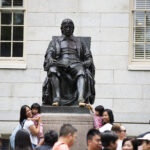While names like Ted Bundy, Dennis Rader (BTK Killer), and John Wayne Gacy are etched in the annals of America’s most notorious serial killers, there’s a figure whose reign of terror, equally brutal, often remains in the shadows: Paul John Knowles. Operating in the 1970s, Paul John Knowles, dubbed the “Casanova Killer,” unleashed a wave of violence across the Southern states, leaving a trail of fear and death in his wake. Despite confessing to 35 murders, authorities officially linked him to at least 18, painting a grim picture of a drifter driven by a seemingly motiveless and vicious impulse to kill.
To delve deeper into the dark narratives of the South, Oxygen’s true-crime series, Sins of the South, explores cases like that of Paul John Knowles, shedding light on the chilling crimes that haunted this region. You can watch Sins of the South on Oxygen Sundays at 7/6c and stream episodes the next day on Peacock.
James Josey, a retired investigating officer, who grappled with the Knowles case firsthand, remarked to Atlanta’s WXIA-TV, “I think he was more vicious than Bundy was.” This chilling assessment underscores the sheer brutality associated with Paul John Knowles’s actions, perpetrated across a landscape now dissected in Sins of the South. Before his violent end in 1974, shot during an escape attempt, Knowles’s self-proclaimed body count of 35 victims, though possibly embellished, hinted at a scale of horror that deeply unsettled investigators. While verification remained elusive, the confirmed cases linked to Paul John Knowles are horrific enough to cement his place among America’s most terrifying criminals.
Echoing the widespread impact of his crimes, a former investigator from Florida station WJXT stated, “Just about everywhere he went he left a body,” highlighting the pervasive fear Paul John Knowles instilled as he moved across state lines.
The Making of a Killer: Who Was Paul John Knowles?
Born in Orlando, Florida, in 1946, Paul John Knowles’s early life was a precursor to his descent into criminality. By his own admission, Knowles recognized his manipulative charm as a tool for illicit activities from a young age. In tapes recorded with a psychiatrist, obtained by WJXT, he confessed, “I’m a criminal, and I’ve been a criminal since I was a little kid,” further stating that “nothing” positive marked his life. This self-perception as inherently criminal offers a glimpse into his psyche, albeit a chilling one.
According to reports from The Macon Telegraph, Knowles’s criminal trajectory began in his teenage years with his first stint in prison. His path took a darker turn in July 1974 when, as reported by WGXA, he escaped from a Jacksonville, Florida jail while being held for stabbing a bartender. This escape marked the unleashing of Paul John Knowles’s most violent spree.
The Casanova Killer’s Modus Operandi
The month of his escape is believed to be the start of Paul John Knowles’s murder spree. Traveling through Georgia, Florida, Texas, Nevada, and Alabama, he is suspected of claiming at least 18 lives. James Josey described his ruthless nature: “He had no compunction about killing you, makes no difference whether he strangled you, whether he shot you, whether he stabbed you or what. He was a martial arts expert. He was tough. He was mean.” This description paints a picture of a cold, calculated killer, adept at violence in multiple forms.
However, the moniker “Casanova Killer” stems from another facet of his personality – his charm. As reported by The Atlanta Journal-Constitution, Knowles even captivated a British newspaper reporter at an Atlanta Holiday Inn bar, engaging in a brief affair. She described him as sensitive and possessing “gaunt good looks,” a stark contrast to his brutal actions. This duality – charming and brutal – is central to understanding the terrifying enigma of Paul John Knowles.
Paul John Knowles, in a 1974 photograph, reveals a glimpse of the man behind the “Casanova Killer” persona. Charged with multiple slayings across several states, Knowles’s case remains a chilling study in criminal psychology. Photo: AP Photo
Victims of Paul John Knowles: A Glimpse into the Darkness
The definitive count of Paul John Knowles’s victims remains shrouded in uncertainty. His claims of 35 murders were met with skepticism, attributed to his craving for notoriety and a desire for fame. Josey recounted to WMAZ that Knowles harbored ambitions for a book and movie deal, with proceeds intended for his mother – a chillingly narcissistic aspiration.
Officially, investigations linked Paul John Knowles to seven murders: four in Georgia, two in Florida, and one in Ohio, as detailed by The Atlanta Journal Constitution. However, the broader consensus among investigators places the victim count at a minimum of 18.
Alice Curtis, 65, of Jacksonville, is considered his first known victim, discovered bound and gagged, according to WGXA. Marjorie Howe, 49, was found strangled with her own stockings in another crime attributed to Knowles. WXIA-TV reported that weapons and a television were stolen from Howe’s residence, suggesting robbery as a potential, though inconsistent, motive.
The case of 13-year-old Ima Jean Sanders, missing from Warner Robins, Georgia in August 1974, highlights the agonizing impact on families. Her remains, found two years later but not identified until decades after, were connected to Paul John Knowles in 2011. Knowles himself, in his recorded confessions, detailed raping and strangling a young hitchhiker named “Alma” in August 1974, as reported by The Atlanta Journal-Constitution. Josey noted the grim irony: “He solved this case himself. He had an ego trip, so he made those tapes. Without those, she’d just be another unidentified victim.”
Kathie Sue Pierce from Musella, Georgia, met a similar tragic fate that same August. Found strangled with a phone cord in her bathroom, her 3-year-old son was left unharmed in the house. In November, Knowles befriended Carswell Carr in Milledgeville, Georgia, only to brutally murder him and his 15-year-old daughter. WJXT reported that Carr was stabbed over 27 times with scissors, while his daughter was strangled – a particularly horrific and personal attack. Former GBI Special Agent Roy Harris, speaking to WGXA, vividly recalled the horror: “Seeing a child killed like that is just awful. It’s something I remember to this day.”
Authorities also suspect Paul John Knowles in the disappearances and presumed deaths of hitchhikers Edward Hilliard and Debbie Griffin in November 1974, further extending the reach of his terror.
The End of the Spree: Capture and Death of Paul John Knowles
Paul John Knowles’s crime spree began to unravel on November 16, 1974, during a routine traffic stop by Florida Highway Patrol Trooper Charles Campbell, as documented by the Officer Down Memorial Page. Knowles overpowered Campbell, seizing his weapon and taking him hostage. Using the trooper’s car, Knowles then abducted James Meyer. WJXT detailed the gruesome climax in Pulaski County, Georgia, where Knowles handcuffed both men to a tree and executed them with shots to the head.
His capture followed shortly after at a roadblock near McDonough. However, the saga of Paul John Knowles concluded dramatically the next month. While being escorted by law enforcement to a crime scene, the 28-year-old Knowles managed to unlock his handcuffs with a paperclip. Lunging for Douglas County Sheriff Earl Lee’s gun, he was fatally shot in the chest by GBI agent Ronnie Angel. Angel, in a statement to the Atlanta Journal Constitution, described Knowles as “evil” and simply stated, “I did what I had to do; I just did my job.”
The story of Paul John Knowles serves as a chilling reminder of the darkness that can lurk beneath a charming facade. To understand more about such sinister figures and the regions they haunted, explore Sins of the South, airing Sundays on Oxygen.


